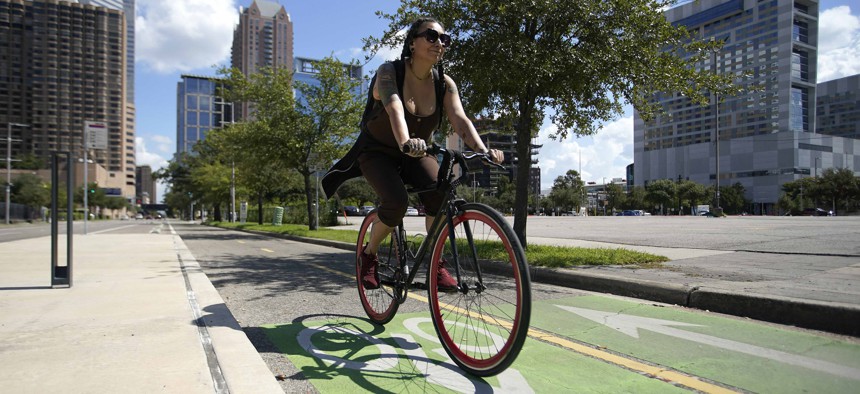Feds tout pedestrian, cyclist safety measures in new road design rules

A bicyclist rides in a bike lane in downtown Houston. Karen Warren/Houston Chronicle via Getty Image
The Federal Highway Administration released long-awaited updates to its manual for traffic signs and road design. The newest edition comes as the country is in the throes of a major upswing in roadway deaths.
The federal government issued new road design standards Tuesday for the first time in 14 years, and Biden administration officials say the long-delayed manual will make roads safer for walkers, cyclists and even motorists on crowded streets.
The latest edition of the "Manual on Uniform Traffic Control Devices for Streets and Highways,” a go-to reference for traffic engineers, includes new advice on how state and local governments should set speed limits.
The new standards downplay—but do not eliminate—long-standing guidance that instructs engineers to set speed limits at a rate that 85% of drivers travel under. Safety advocates have argued that the 85th-percentile rule encourages people to drive faster, regardless of whether it’s safe to do so.
The manual, or MUTCD, says that transportation agencies should weigh six factors when they use engineering studies to set speed limits: the roadway environment, roadway characteristics, geographic context, crash experience, speed distribution and an analysis of speed trends. (The engineering studies aren’t needed where speed limits are determined by law, such as when a city sets a limit for all residential streets.)
“This change clarifies that the engineering study is not just limited to the speed distribution and that the context of the roadway is part of the study,” the Federal Highway Administration, or FHWA, wrote in the document. “The guidance also clarifies that on urban and suburban arterials and rural main streets, the 85th-percentile speed should not be used as the sole consideration in setting speed limits.”
The agency encouraged state and local governments to use additional measures on top of speed limit signs to slow traffic in places where most drivers regularly exceed the posted speed limit.
In an interview with Route Fifty, FHWA Administrator Shailen Bhatt said the newest update to the design manual reflects a shift in emphasis from years past.
“Going back to the 1950s and 60s, we were very focused on how we move more cars and trucks,” he said. “Now, what we have awakened to in the 21st century is: How do we move the people? It’s not just about moving people and cars and trucks. It’s about moving people in buses, walking and cycling.”
Ken McLeod, the policy director for the League of American Bicyclists, said the changes were significant.
“I’d say for the most part, the reality meets the rhetoric,” he said. “It’s great that there are so many new types of bike facilities discussed in the document. Separated bike lanes are in the MUTCD for the first time ever. And there are really good illustrations of how to do them, and how to manage them in intersections.”
The newest edition of the MUTCD also comes as the country is in the throes of a major upswing in roadway deaths since the beginning of the pandemic, with roughly 43,000 traffic fatalities a year. The Biden administration is trying to reverse that trend by pushing a “safe systems” approach that relies on a web of safety measures—from safer roadways to safer vehicles, safer speeds and better emergency response times—to prevent traffic crashes and minimize the damage when they do occur. The revision of the MUTCD is one of its biggest opportunities to reshape the country’s roadways to match that vision. The document explicitly states: “Protection of vulnerable users is a priority in this manual.”
Bhatt said some of this year’s changes include doubling the size of the section on bike-oriented infrastructure. It endorses some frequently used road treatments, such as painting bike lanes green or introducing special traffic signals for cyclists, that previously didn’t have the full imprimatur of the federal government.
The new document also includes standards for the location of push buttons for people with disabilities at signalized intersections, along with standardized crosswalk markings and audible signals.
But Bhatt said the FHWA is not relenting on its prohibition of experimental crosswalk designs, which many cities use to give neighborhoods a sense of place and to encourage motorists to slow down.
“We’re always trying to push safety, and when it comes to safety, we should err on the side of safety, not of caution, because too many times we’re hesitant to make changes,” Bhatt said. “But one of the attributes of our transportation system is that it is a uniform experience. If you drive from New York City to L.A., all along that route—whether it’s in the cities or in the countryside—all your signs are the same. You don’t encounter new experimental signs unless they’re carefully thought through.”
“Things don’t become adopted as a standard unless they go through a rigorous process because we don’t want Americans to be surprised by something that is purportedly a safety device, but it’s something they’ve never seen before. And it’s only in one location,” he said. “We want to differentiate between safety devices such as a crosswalk and street art. We want people to exercise good judgment, to keep their focus on safety and not do anything that would prevent somebody from having a safe experience. I’m just not interested in being the street art police.”
The newest revisions of the MUTCD will mark the 11th time the document has been updated since it was first published in 1935. Typically, new editions came about every decade or so. But the 2021 infrastructure law mandates that, in the future, the document should be updated every four years.
Transportation agencies don’t always follow every rule outlined by the MUTCD (such as when they paint crosswalks to resemble rainbow Pride flags or piano keys), but doing so helps protect them from liability and ensures that they comply with rules for federally funded projects. Engineers often consult it—along with manuals produced by the American Association of State Highway and Transportation Officials, or AASHTO—to decide what they can and cannot do to change road designs.
Beth Osborne, the director of Transportation for America, said state transportation departments often balked at suggestions her group would make to improve cyclist or pedestrian safety, especially at intersections, because they were not authorized by the MUTCD.
“They all believe that the feds prohibit them from even trying new designs, especially in terms of color in crossings, due to the MUTCD,” she said. “What we see as better visibility is almost universally viewed by DOTs as a distraction due to their unified interpretation of the MUTCD. I don’t get how drawing a driver's attention to where pedestrians might cross is a distraction, but we have heard this so many times.”
McLeod from the cyclist group said the revisions “should ease those worries” because the treatments are part of the national standard. The manual specifically refers to a bikeway selection guide that FHWA released in 2019, helping traffic engineers decide which treatments are best for a project. AASHTO is also expected to release an updated version of its bike infrastructure manual soon, McLeod noted. “If that becomes more widely known and more widely used,” he said, “we can really hopefully see a sea change and how jurisdictions are approaching separated bike lanes.”
The gap between the latest revisions of the MUTCD in 2009 is especially significant given the amount that the transportation landscape has changed since then. The use of smartphones has more than doubled. City transportation officials have organized and promulgated their own street design guides, often as an alternative to manuals produced by state agency officials, that promote “complete streets'' and a mix of transportation modes for urban settings. The concept of “Vision Zero'' took hold in the U.S., popularizing the idea that engineering roads to slow vehicles rather than speed them up could help reduce traffic fatalities.
The Trump administration released a draft for an update three years ago, just as the Republican president’s term was coming to an end. But safety advocates and local leaders criticized the effort as being too focused on moving vehicles quickly, and not focused enough on improving safety. More than 25,000 people offered public comments on the document.
Daniel C. Vock is a senior reporter for Route Fifty based in Washington, D.C.
NEXT STORY: Plans to install EV charging stations are about to run into an ugly wall of permitting and utility delays






